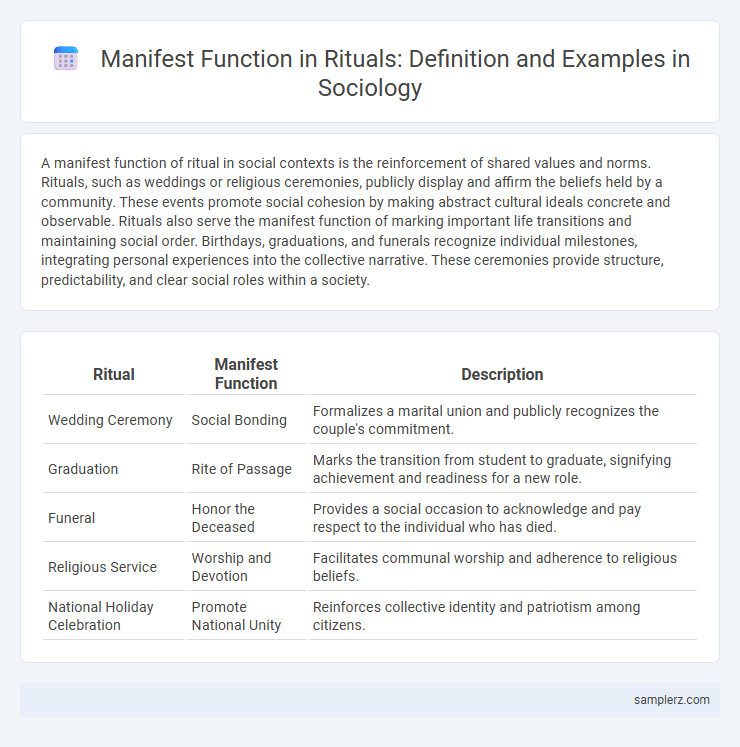A manifest function of ritual in social contexts is the reinforcement of shared values and norms. Rituals, such as weddings or religious ceremonies, publicly display and affirm the beliefs held by a community. These events promote social cohesion by making abstract cultural ideals concrete and observable. Rituals also serve the manifest function of marking important life transitions and maintaining social order. Birthdays, graduations, and funerals recognize individual milestones, integrating personal experiences into the collective narrative. These ceremonies provide structure, predictability, and clear social roles within a society.
Table of Comparison
| Ritual | Manifest Function | Description |
|---|---|---|
| Wedding Ceremony | Social Bonding | Formalizes a marital union and publicly recognizes the couple's commitment. |
| Graduation | Rite of Passage | Marks the transition from student to graduate, signifying achievement and readiness for a new role. |
| Funeral | Honor the Deceased | Provides a social occasion to acknowledge and pay respect to the individual who has died. |
| Religious Service | Worship and Devotion | Facilitates communal worship and adherence to religious beliefs. |
| National Holiday Celebration | Promote National Unity | Reinforces collective identity and patriotism among citizens. |
Enhancing Social Cohesion Through Rituals
Rituals serve as manifest functions by enhancing social cohesion through shared practices and collective participation. These ceremonies reinforce group identity and establish social norms, fostering a sense of belonging among participants. Public rituals such as weddings, religious festivals, and national holidays visibly strengthen communal bonds and cultural continuity.
Reinforcing Cultural Values via Ceremonial Acts
Rituals such as weddings and religious ceremonies serve the manifest function of reinforcing cultural values by publicly affirming shared beliefs and norms. These ceremonial acts provide social cohesion by uniting participants in collective expressions of identity and tradition. Through symbolic gestures and prescribed rites, rituals transmit cultural heritage and strengthen community bonds.
Establishing Group Identity in Communal Gatherings
Rituals like weddings, religious ceremonies, and national holidays serve a manifest function by establishing group identity in communal gatherings. These events reinforce shared values, beliefs, and social norms, fostering a sense of belonging and unity among participants. The collective participation strengthens social cohesion and distinguishes the group from others through symbolic acts and traditions.
Facilitating Socialization in Traditional Rituals
Traditional rituals play a crucial role in facilitating socialization by providing structured environments where individuals learn cultural norms, values, and roles. These ceremonies foster community bonding through shared experiences and reinforce group identity, ensuring continuity of social order. Participation in rituals such as weddings, coming-of-age ceremonies, or religious festivals helps individuals internalize societal expectations and develop interpersonal skills.
Marking Life Transitions with Rites of Passage
Rites of passage serve as manifest functions in rituals by explicitly marking significant life transitions such as birth, puberty, marriage, and death within a society. These ceremonies provide structured social recognition and validation of individual changes, reinforcing social roles and group identity. The clear, symbolic acts performed during these rituals help individuals and communities navigate and accept new social statuses.
Maintaining Social Order Through Ritual Practices
Rituals like weddings and religious ceremonies serve to reinforce social norms by publicly affirming shared values and roles, ensuring community cohesion. These manifest functions help maintain social order by creating predictable patterns of behavior and strengthening collective identity. Through repeated ritual practices, societies establish stability and continuity across generations.
Public Demonstration of Collective Beliefs
A manifest function of social rituals is the public demonstration of collective beliefs, which reinforces group identity and shared values among participants. Rituals such as national holidays, religious ceremonies, or political rallies visibly express communal ideals and strengthen social cohesion. This public display fosters solidarity by aligning individual behaviors with the broader cultural framework.
Encouraging Community Participation in Festivities
Rituals like annual festivals serve the manifest function of encouraging community participation by bringing diverse groups together in shared celebration. These events foster social cohesion and collective identity through coordinated activities such as parades, dances, and communal meals. By actively involving participants, rituals strengthen communal bonds and promote cultural continuity.
Institutionalizing Norms via Repetitive Rituals
Rituals serve to institutionalize social norms by embedding shared values through repetitive ceremonies, such as daily flag salutes in schools that reinforce national identity and respect for authority. These rituals consistently transmit cultural expectations, ensuring conformity and social cohesion within institutions. Over time, repeated participation in rituals solidifies prescribed behaviors, making norms an integral part of institutional frameworks.
Educating New Members Through Ritual Observance
Rituals serve a manifest function by educating new members about societal values and norms, reinforcing social cohesion. Through repeated participation, individuals internalize cultural symbols and ethical codes essential for group identity. This educational process ensures continuity and stability within the social structure.

example of manifest function in ritual Infographic
 samplerz.com
samplerz.com